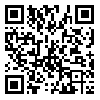BibTeX | RIS | EndNote | Medlars | ProCite | Reference Manager | RefWorks
Send citation to:
URL: http://irje.tums.ac.ir/article-1-5635-en.html

 , B Najafi2
, B Najafi2 
 , V Yazdi Feyzabadi3
, V Yazdi Feyzabadi3 
 , AA Haghdoost4
, AA Haghdoost4 
 , M Abolhallaje5
, M Abolhallaje5 
 , M Ansari6
, M Ansari6 
 , R Dehnavieh7
, R Dehnavieh7 
 , M Ramezanian8
, M Ramezanian8 
 , F Kouhi9
, F Kouhi9 
 , M Jafari10
, M Jafari10 
 , Lashkari M *
, Lashkari M * 
 11
11
2- دانشکده مدیریت و اطلاع رسانی پزشکی، دانشگاه علوم پزشکی تبریز
3- دکترای تخصصی سیاستگذاری سلامت، مرکز تحقیقات عوامل اجتماعی موثر بر سلامت، پژوهشکده آینده پژوهشی در سلامت، دانشگاه علوم پزشکی کرمان، کرمان، ایران
4- استاد اپیدمیولوژی، مرکز تحقیقات مدلسازی در سلامت، پژوهشکده آینده پژوهشی در سلامت، دانشگاه علوم پزشکی کرمان، کرمان، ایران
5- استادیار مدیریت خدمات بهداشتی درمانی، دفتر بودجه و پایش عملکرد، وزارت بهداشت، درمان و آموزش پزشکی، تهران، ایران
6- کارشناس ارشد مدیریت خدمات بهداشتی درمانی، مرکز تحقیقات مدیریت ارائه خدمات سلامت، پژوهشکده آینده پژوهی در سلامت، دانشگاه علوم پزشکی کرمان، ایران
7- دانشیار مدیریت خدمات بهداشتی درمانی، مرکز تحقیقات مدلسازی در سلامت، پژوهشکده آینده پژوهشی در سلامت، دانشگاه علوم پزشکی کرمان، کرمان، ایران
8- دانشجوی دکترای آینده پژوهی در سلامت، دفتر بودجه و پایش عملکرد، وزارت بهداشت، درمان و آموزش پزشکی، تهران، ایران
9- کارشناس ارشد اقتصاد سلامت، سازمان تأمین اجتماعی، تهران، ایران
10- دکترای مدیریت استراتژیک، سازمان بیمه خدمات درمانی استان کرمان، کرمان، ایران
11- کارشناس ارشد مدیریت خدمات بهداشتی درمانی، مرکز تحقیقات مدیریت ارائه خدمات سلامت، پژوهشکده آینده پژوهی در سلامت، دانشگاه علوم پزشکی کرمان، کرمان، ایران ,
Background and Objectives: Out-of-pocket (OOP) expenditure is one of the main indicators in health financing, indicating risk pooling and risk spreading. This study aimed to calculate the total health expenditure (THE), the THE per capita and share of OOP in each province from 2008 to 2014.
Methods: The present cross-sectional study was done by collecting provincial health expenditure data from public and private organizations during 2008-2014. The data were approved by board of trustees or board of directors in each organization. The relevant data on household health expenditures were collected from the Statistical Centre of Iran, as well.
Results: Even though the absolute monetary value (IRR) of OOP in the study years showed an increase, it decreased from 51.9% in 2008 to 40.6% in 2014 in terms of share. The absolute monetary value (IRR) of THE and THE per capita increased about 3.5 times in all provinces. So, during the study years, Tehran and Sistan and Baluchistan Provinces had the highest and lowest absolute monetary values (IRR) in THE per capita and this difference increased from 2.12 million Rials in 2008 to 10.56 million Rials in 2014.
Conclusion: Although the share of OOP decreased in all provinces in the country during the study years, it is still far from the objective of the national development plans (30% OOP). In order to improve the study indices and reduce the provincial inequity, it is suggested to put more emphasis on prepaid-based mechanisms, insurance system improvement, and equitable distribution of financial resources should be compatible with the deprivation of the area and its infrastructures.
Received: 2017/02/21 | Accepted: 2017/02/21 | Published: 2017/02/21
| Rights and permissions | |
 |
This work is licensed under a Creative Commons Attribution-NonCommercial 4.0 International License. |



